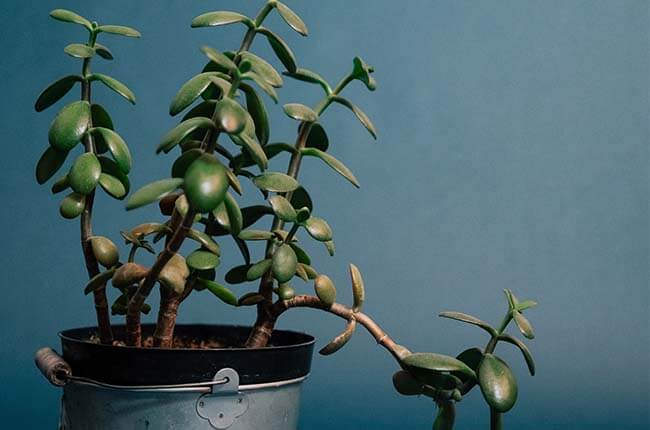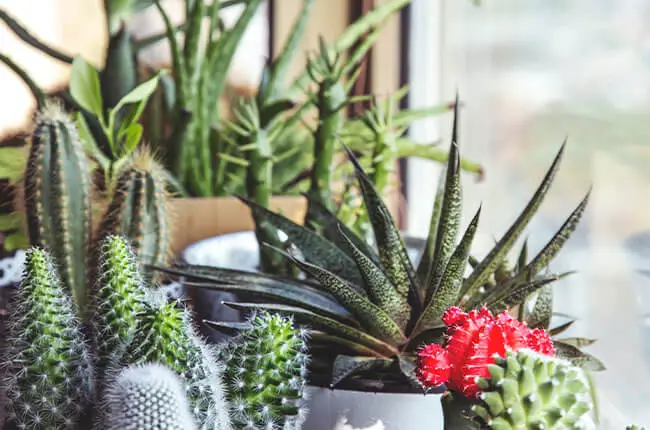Succulents are such versatile plants that can be grown indoors and outdoors. But how much light do your succulents need, so that they don’t suffer from too little light indoors or too much light outdoors?
Succulents grow to their best compact form, leaf size, and healthy pigmentation under filtered light of 75-150 μmol/m2/s for 4 to 6 hours. They can tolerate as little as 35 μmol/m2/s (office light) before their growth is hindered or as much as 150 μmol/m2/s (direct sunlight) before they get burnt.
To learn more about how much light succulents need and how they behave under different lighting, read on.
How much light do succulents need?
The optimal sun exposure for succulents is a medium to strong filtered light for at least 4 to 6 hours, depending on the species.
In Photosynthetic Photon Flux Density (PPFD) units, the optimal intensity for succulents is between 75 and 150 μmol/m2/s, which is slightly more than the light needs of Phalaenopsis orchids and less than the optimal light for Oncidiums.
This is according to a study where succulents grown under a medium light intensity (75 μmol/m2/s) and a high light intensity (150 μmol/m2/s) are found to have developed a glowing green color on their leaves, and a better compact form than succulents with elongated stems grown under a low light intensity (35 μmol/m2/s) (Cabahug, Soh & Nam, 2017a).
Another study also showed that succulents grow well and achieve better leaf pigmentation when put under 120 μmol/m2/s of light for 6 hours (Nam, Lee, Soh, & Cabahug, 2016).
Succulents under mild lighting not only can develop a healthy appearance but can also grow larger leaves than being under high light exposure.
In fact, the stronger the light, the wider the range of green to red hues the succulent develops. Some people expose their succulents under strong light on purpose, a technique also known as “sun stressing”, in order to achieve such pretty colors.
But one must be careful not to expose their succulents to light too strong to prevent sunburn on the leaves.
Low lighting conditions, on the other hand, can lead to “bolting” or etiolated stems, dull green color, and a hindrance on the growth of succulents.
More about the effects of low and strong light on succulents later.
For now, here is a quick summary:
| Light intensity (PPFD) | Impact on succulent health |
| Low (35 μmol/m2/s) | Elongated stems, smaller leaves, dull green |
| Medium (75 μmol/m2/s) | No elongated stems, good leaf size, glowing green |
| High (150 μmol/m2/s) | No bolting, good leaf size, glowing green plus a range of red hues |
| Too strong (150 μmol/m2/s) | Sunburn with white or dark patches on leaves |
To measure light exposure in PPFD, consider getting a PAR light meter for plants.
PAR Light Meters for Plants | Review |
Editor’s pick 1. Photobio LGBQM2 | Features
• Measures all light sources
• Bulky case |
Laboratory grade for professionals 2. Apogee MQ-500 | Features
|
3. Apogee DLI-400 | Features Pros • Durable Cons • Expensive |
4. Quantum PAR Meter (METER) | Features
• Measures all sources of light • Breaks easily |
5. Quantum Sun (Generic) | Features Pros • Affordable
• Not as precise as other models |
6. VABIRA VBR-200 | Features • Measures all sources of light, as well as humidity and temperature Cons • Has to be plugged in to get a reading |
Best Value 7. FUTUREHORTI | Features • Versatile, can be moved to hard-to-reach areas • Needs internet |
8. VABIRA VBR-100 | Features Pros • Versatile, can be moved to hard-to-reach areas • Needs internet |
Can succulents thrive in low light?
Succulents will not grow into their best state, but they survive in low-light locations such as covered patios, under porch roofs, beneath trees, indoors in a room with no window or away from the window, etc.
Low light does not mean a total absence of light, which can indeed reduce your plant’s production of food because of the inability to photosynthesize, a phenomenon called photo-inhibition.
If you do not have access to enough light for your succulents, you can give them additional light for a week or two from time to time, especially during their growth phase.
Consider using grow lights to supplement or even replace natural light.
- For fluorescent tube lights and bulbs, it is recommended to put them 6-12 inches away from your succulents. For LED light, the recommended distance is 18 – 24 inches.
- For stimulating the growth of succulents, the best color temperature is 6500k (cool white). If you want your plant to bloom, a 3000k (warm white) light is better.
- Run grow lights for 10-16 hours during daylight hours.
What are the signs of too little light?
So, how do you know if your succulents are receiving enough light, especially if you don’t have a light meter? Here are the signs of succulents growing in low light:
- Stems elongate or become etiolated or “leggy”, with wide gaps between leaves and lose its usual compact form to search for a stronger light source.
- Weak stems
- Smaller leaves
- Leaves and outer leaves of rosettes point downwards
- Dull shade of green on the leaves
- Early fall of leaves and flowers

How to fix leggy succulents?
You can correct etiolation by giving your succulent the right intensity and duration of light it needs.
However, stems that are already elongated will not shorten back to their previous state even with more light exposure.
If you want to fix your succulent’s aesthetics, you will need to trim off the top part of its stem. By removing a portion of its stem, you are helping your plant get a fresh start to grow again.
Can succulents handle full sun?
Most succulents cannot handle full sun for over six hours. In fact, the natural habitat of most succulent species is semi-arid places with occasional rainfalls.
When exposed to direct sunlight without any protection, they can suffer permanent scarring or die in the worst-case scenario.
Interestingly, scars on some succulents such as Kalanchoe have been found to heal themselves and can be peeled off after a couple of months.

To prevent sunburn or sun damage, it is better to start with some partial shade and gradually increase the amount of time it spends in the sun.
What are the signs of too much sun?
When succulents are under excessive sunlight, they show these signs of stress:
- They change color; pigments will look washed out and bleached.
- They develop white or pale patches on their leaves
- Their outer edges and will be dry and crispy
- Leaves turn completely black in the worst case
How to treat sunburned succulents?
There are several measures you can take to help your succulents recover from sunburn.
Move them to a location with less light.
Alternatively, you can keep your succulents in the same area and provide shade – use a shade net or prop up an umbrella over the plant to block out the sunlight.
Remove damaged leaves. Cut off leaves with brown and black spots by using sterilized scissors or a knife. You may opt to use healthy leaf cuttings to propagate new plants.
Use a shade net that suits your plants’ needs.
Keep your succulents hydrated; mist the soil lightly early in the morning.
Best natural light for succulents?
If you grow your succulents indoors, the best spot is on a windowsill by an east- or west-facing window. Light from a south-facing window needs to be filtered by a curtain.
If you grow your succulents outside in the garden, place them at a spot so that they do not come under direct, strong sunlight around noon. This can be achieved by placing them close to a tree, a bush or a taller plant so that it is under a partial shade or filtered light during the hottest hours of the day.
Conclusion
To sum up, the optimal range of light for succulents is between 75 and 150 μmol/m2/s for 4 to 6 hours to prevent any hindrance to growth and sunburn.
This range of light will result in healthy growth, a beautiful compact succulent, big leaves, and healthy leaf colors.
Happy gardening!
Related
Top 8 PAR Meters for plants (Reviewed)
Add Stress Colors to Succulents Indoor (With LED Light)
How Much Light Do Orchids Need? (with Light Chart)
References
Afra, A. (2018). The Succulent Manual: A Guide to Care and Repair for All Climates.
Agrios, G. (2005). Chapter Ten – Environmental Factors That Cause Plant Diseases. Plant Physiology. 357-384. doi: 10.1016/B978-0-08-047378-9.50016-6
Brown. D. (2018) Cacti and Succulents. University of Minnesota.
Cabahug, R., Soh, S.Y., & Nam, S.Y. (2017a). Effects of Light Intensity on the Growth and Anthocyanin of Echeveria agavoides and E. marcus. Flower Res. J., 25(4). 262-269. doi: 10.11623/frj.2017.25.4.11
Cabahug, R., Soh, S.Y., & Nam, S.Y. (2017b). Effects of Shading on the Growth, Development, and Anthocyanin Content of Echeveria agavoides and E. marcus. Flower Res. J., 25(4). 270-277. doi: 10.11623/frj.2017.25.4.12
Demming-Adams, B. & Adams III, W.W. (2016). Photoinhibition. In Thomas, B., Murray, B. & Murphy D., Encyclopedia of Applied Plant Sciences. 78-85. doi:10.1016/B978-0-12-394807-6.00093-9.
Egri, Á., Horváth, Á., Kriska, G. and Horváth, G. (2010), Optics of sunlit water drops on leaves: conditions under which sunburn is possible. New Phytologist, 185: 979-987. doi: 10.1111/j.1469-8137.2009.03150.x
Griffiths, H. & Males, J. (2017). Succulent Plants. Current Biology. 27(17). 890-896.doi: 10.1016/j.cub.2017.03.021.
Missouri Botanical Gardens. (n.d.). Cacti and Succulents.
Nam, S.Y., Lee, H.S., Soh, S.Y., & Cabahug, R. (2016) Effects of Supplementary Lighting Intensity and Duration on Hydroponically Grown Crassulaceae Species.Flower Res. J., 24(1). doi: 10.11623/frj.2016.24.1.1
- Keiki Paste vs Rooting Hormone:What’s the difference? - February 4, 2024
- Top 10 Orchid Fertilizers: A Comprehensive Review (2024) - February 2, 2024
- Top 8 Soil Inoculants For Stronger Plants (2024) - February 1, 2024










